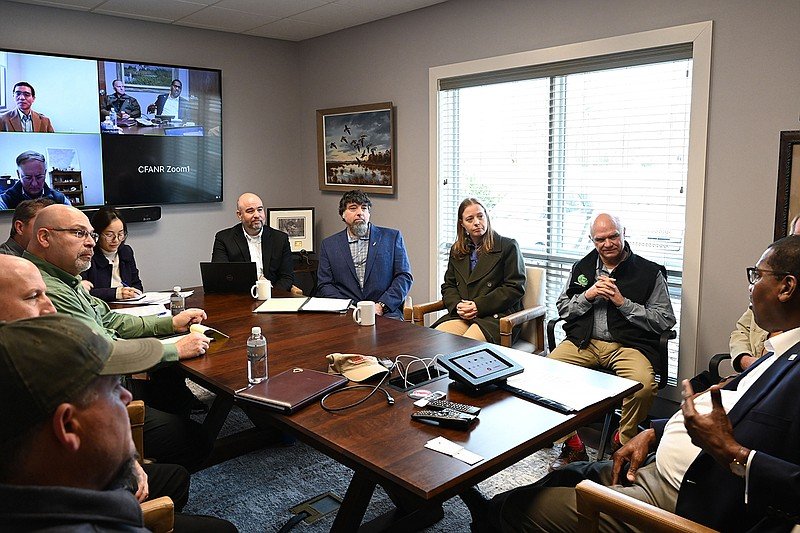UAM to lead $3.7M tree restoration work
View the original article at arkansasonline.com
A $3.7 million grant procured by a University of Arkansas at Monticello professor will help restore bottomland hardwood forests in the state's southern bottomland region.
The five-year grant from the U.S. Department of Agriculture will encompass efforts from UA-Monticello, the Arkansas Forest Resources Center, the University of Arkansas at Pine Bluff and Texas A&M University.
This is "a very big collaborative project," said Nana Tian, an assistant professor of natural resources economics and policy at UA-Monticello who developed the winning grant proposal and is primary investigator on the project. "We can learn from our colleagues, and we can all make our own contributions."
UA-Pine Bluff, for example, "has a great program, and [they've] reached a lot of minority landowners with targeted resources," said Michael Blazier, director of the Arkansas Forestry Center and dean of UA-Monticello's College of Forestry, Agriculture and Natural Resources. "Forests were cleared for subsistence farming when white settlers moved into the Arkansas Delta, [which is now] an impoverished area, and we're doing what we can to help that region."
A goal of the project is planting 500 to 600 acres of oak forests in the agriculturally dominant floodplain of the Red River Valley of southwestern Arkansas, the Ouachita River Valley of south-central Arkansas, and the Bayou Meto Watershed in eastern Arkansas, according to Tian, a researcher for the Arkansas Forest Resources Center, a partnership between UA-Monticello and the Division of Agriculture through the Arkansas Agricultural Experiment Station.
This initiative will also "quantify and demonstrate the ecological and economic benefits of bottomland hardwood forest restoration on working lands and help landowners manage the plantations and market climate-smart commodities."
Bottomland hardwood forests -- also known as riverine swamps -- are "a very important ecosystem in the state," but roughly 70% of that acreage in the Arkansas Delta has been lost over the last century, said Tian, who has been focused on bottomland hardwood forests for the past couple of years and published multiple scientific papers on the subject. More forestation is essential, because it's not only a crucial habitat for wildlife -- particularly waterfowl -- but the source of "high-quality wood products."
For example, homes built with hardwood last decades longer than homes not constructed with it, and Arkansas ranks ahead of all other states in production of hardwood ceilings, Blazier said. Arkansas is a leading light for forestry in the country -- "Arkansas has grown enough forest in the last 20 years to cover the state of Delaware" -- and forests are "an integral [part] of what makes Arkansas 'The Natural State.'"
Bottomland hardwood forests are "great for hunting and recreating, both of which are big drivers for the Arkansas economy," and the state is also well known for its waterfowl, "but the loss of red oaks within bottomland forests in Arkansas impacts wildlife," he said. "We want to sustain our prominence" as a place for waterfowl, and red oaks provide "the preferred acorn of ducks."
Red oak is a pivotal species in the Arkansas Delta, not only economically, "but culturally," Tian said. Though it's considered "climate-smart agricultural/forestry practice" to restore bottomland hardwood forests, small and underserved family landowners face various barriers to implementing the practice, even though they are critical to it.
Many of these landowners have lived on -- and managed -- their lands for generations, but they have limited resources and access to financial and technical assistance, she said. Tian and others associated with the grant will collaborate with them and provide financial, technical and management assistance where necessary.
In addition to planting 500 to 600 acres of oak plantations, "we hope to answer lots of research questions" over the five years of this grant, she said. This project can demonstrate the economic and ecological benefits of reforestation efforts, which could encourage others in the state and country to embark on similar initiatives.
"When we're successful, we can showcase [these forests] and use them to teach," Blazier said. "Seeing is believing."
These forests can also mitigate climate change, which "benefits everyone," not only in the region and the state, but in the nation and world, Tian said.
Bottomland hardwood forests "absorb lots of carbon," Blazier said. "The best thing we can do is take vacant or underutilized fields we have in the Arkansas Delta and establish bottomland hardwood forest on them."


